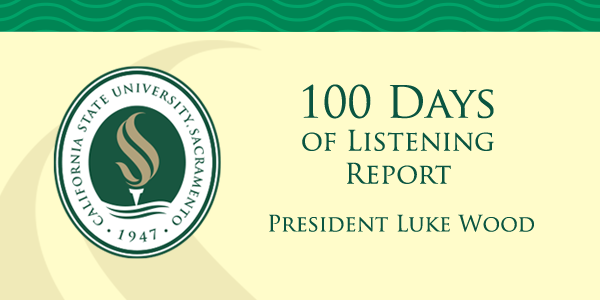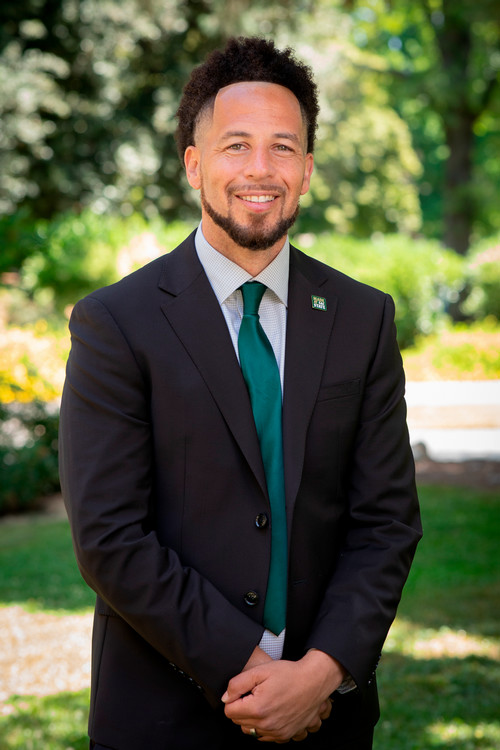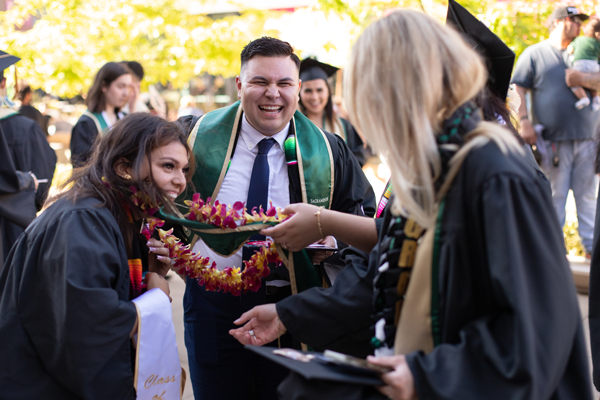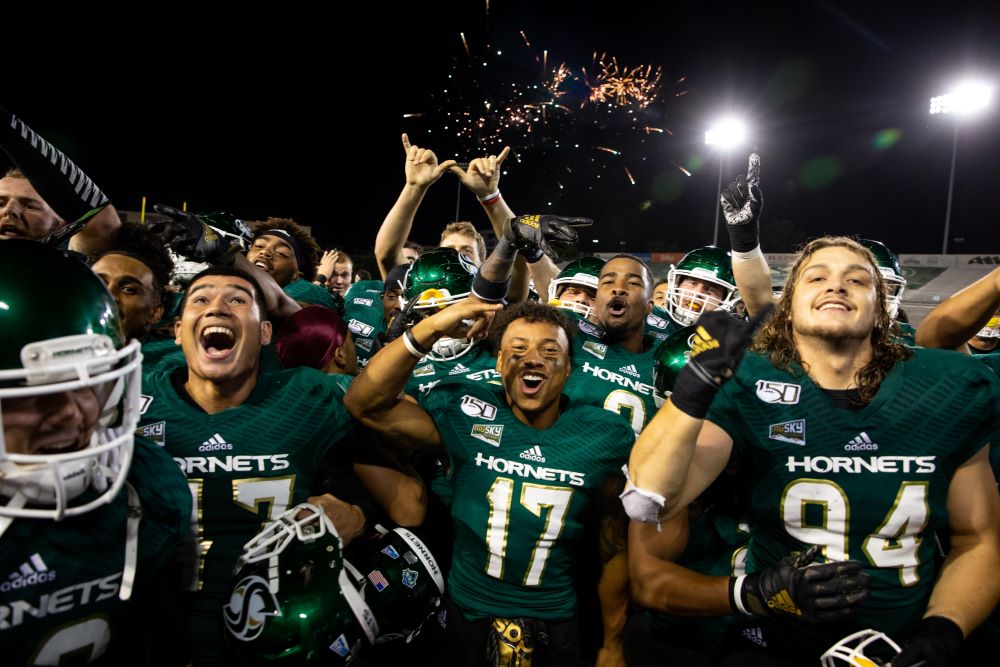Support Page Content
President Wood’s 100 Days of Listening

Letter from President Wood
 Dear Hornet Family,
Dear Hornet Family,
I am excited to share with you this report summarizing what we learned during my 100 Days of Listening. When I arrived on campus last July, I was struck by the incredible growth and transformation that has taken place since I was a student here 20 years ago. Our graduation rates have soared, new facilities have been built, our athletics programs have achieved great successes, and our arts programs have become world-class.
Just before I became President, Sacramento State had adopted an inspiring new Strategic Plan centered on imperatives that are at the core of who we are and what we aspire to achieve. Though the plan had impressive goals, it did not yet have action items.
To chart a course for Sacramento State's future, I spent the fall semester engaged in a “100 Days of Listening” tour. During the 92 sessions we held, I had the privilege of hearing from over 1,500 students, faculty, staff, administrators, alumni, and community members. In each of the sessions, I asked participants to share their perspectives on what makes Sacramento State distinctive, where they hope to see the University in five years, and what concrete steps we can take to get there while remaining committed to diversity, equity, inclusion and belonging.
The passion for Our Sacramento State and the devotion to our students was evident in every session. You spoke candidly about what we do well and where we can improve. Your insights, ideas, and experiences are the foundation of this report, which summarizes what I heard in a spirit of openness, honesty, and commitment to positive change.
I am humbled and inspired by the time and thought you devoted to this process. Thank you for caring so deeply about Our Sacramento State and for working to make this University the best it can be so that we can continue to achieve our mission of transforming the lives of our students and their families. I look forward to partnering with you as we take action to shape an even brighter future for Sacramento State.
Stingers Up!
Luke Wood
President
Themes

What’s working:
- Mission-driven faculty and staff: You are dedicated to and passionate about supporting students.
- Soaring graduation rates: Thanks to our faculty and staff, Sac State has seen an impressive 212% increase in the four-year graduation rate.
- Hands-on experience: Our students get valuable hands-on learning opportunities, making our graduates highly desirable to employers.
What needs work:
- Redefining student success: It’s time that we reconsider how we define “student success” by including factors beyond graduation, such as job placement and income.
- Empowering affinity centers: We must allocate resources to our centers for greater impact on student success and sense of belonging.
- Centralized advising: We must streamline advising services for easier access and better guidance.
- Universal internship opportunities: We need to ensure all students can access valuable internship experiences, potentially through centralized coordination.
- Enhanced campus life: It is time for Sac State to invest in more housing and improved facilities to foster student success by creating a vibrant student community on campus.
- Financial support: Barriers to financial stability for our students include a low scholarship utilization rate and understaffed financial aid office, both of which we must address to ensure equal access to educational opportunities.
- Holistic student well-being: We have work to do to create a comprehensive support system for students' physical, emotional, and cognitive well-being.
Overall, I heard that Sac State is deeply committed to student success, and that you are proud of how far we have come over the last several years. However, we have significant opportunities for improvement by providing more resources to student affinity centers, ensuring access to financial support, and providing improved advising services.
What I heard:
When I came to Sac State, the students blew me away. The students drive me to be here and to stay here.
What’s working:
- Valuing our diversity: Our diverse student body, with a high percentage of first-generation students from a wide variety of backgrounds, is valued as one of our most distinctive features.
- A growing commitment: Over the past few years, campus has made strides in ensuring we are an anti-racism campus, focused on justice, equity, diversity, and inclusion.
- Acknowledgement of where we need to be: We have made progress in improving hiring, retention, and evaluation using JEDI informed principles.
What needs work:
- Faculty diversity gap: Increasing faculty diversity remains a critical goal.
- HSI/AANAPISI potential: Fulfilling the promises of HSI and AANAPISI designations to meaningfully serve our students needs more attention.
- Closing equity gaps: Eliminating persistent equity gaps requires more resources and implementation of proven practices.
- Empowering employee affinity groups: These groups are not well-resourced or otherwise supported.
- Inclusive learning environments: Improving classroom setups and furniture to better accommodate all students and to encourage inclusive teaching practices.
Overall, I heard a strong commitment to Sac State’s Antiracism and Inclusive Campus Plan (AICP), and pride in the progress we have made in these efforts since the plan’s inception. However, we must commit to improving efforts to strengthen diversity, address equity gaps, and create a more inclusive environment for all.
What I heard:
I think our focus on diversity in faculty hiring and on retention of faculty is immensely important and needs to remain central to our efforts. Our student body is diverse and our students want to see themselves reflected in the faculty and thus to be seen and heard themselves.
What’s working:
- High-impact practices: Our academic programs prepare students for real-world success by engaging them in high-impact practices including partnering with faculty in research and creative endeavors.
- Highly sought-after academic programs: Numerous programs on campus are high-ranking and sought-after including Nursing, Criminal Justice, Computer Science, and Engineering.
- Rich graduate offerings: Our graduate programs are diverse and impactful, attracting top students and professionals.
- Innovative support: We have numerous tutoring and supplemental instruction programs available to support our students.
What needs work:
- Advising and guidance: We must streamline our decentralized academic advising, ensure students have access to up-to-date program roadmaps, and improve Hornet Launch to ensure proper course availability for all students.
- Online learning: Departments need to examine online course offerings for quality and accessibility.
- Capacity limitations: Many of our programs turn away qualified students. We must find innovative ways to expand access.
- Graduate infrastructure: There is a desire and a need to grow graduate programs, but we must first provide the appropriate resources and infrastructure.
- Undergraduate-graduate bridge: We have an opportunity to build a smoother transition path between our undergraduate and graduate studies programs.
Overall, I heard that Sac State shines with its strong academic programs, but that we must enhance student support through a centralized advising program and clear access to optimize online learning, and address capacity limitations to fully flourish.
What I heard:
Our students are highly sought after when they graduate because we give them a large hands-on component.
What’s working:
- R2 designation on the horizon: Recognition of the impressive work already being done by our faculty.
- Student research opportunities: Faculty actively involve students in their research endeavors, a high-impact practice that improves student success.
What needs work:
- Discouraged grant seeking: Persistent issues with sponsored projects and inadequate post-grant administration has created barriers to effective grant utilizations, frustration, and too many faculty no longer seeking grants. We must revamp sponsored projects management and post-grant processes to inspire and support increased grant applications.
- Release time hurdles: Unevenly distributed release time opportunities hamper the ability of faculty to do long-term planning and create scheduling and course coverage challenges.
- Heavy faculty workload: The expectation of a 4/4 teaching load alongside research, administrative duties, advising, and committee work is unsustainable, with workload inconsistencies across departments.
Overall, I heard that Sacramento State has impressive research and creative activity happening in all areas, but that bottlenecks and barriers have created massive problems in post-grants administration for far too long. I also heard that it is time to reassess faculty workload and find ways to ensure a healthier balance between teaching, research, and other responsibilities while addressing departmental discrepancies. By tackling these challenges, Sac State can foster a flourishing environment where its world-class researchers and creatives can continue to excel, inspire, and engage our students.
What I heard:
I think we have faculty who are truly committed to the institution and its students. There is a strong culture of effective teaching and continuing professional development in teaching.
What’s working:
- What makes us distinctive: Our deep and meaningful commitment to community engagement is one of Sac State’s most distinctive features.
- A regional anchor: We are known in the region for our growing community engagement and for our commitment to strengthening the region through numerous service-learning and research programs.
What needs work:
- Underutilized Capitol proximity: We must do a better job of leveraging the unique advantage of being near the state's center of power to forge impactful partnerships and address critical issues.
- Limited staff engagement: Staff expressed that they would like expanded opportunities to contribute their skills and expertise to community initiatives.
- Disconnected alumni: We can improve our connections with alumni by doing a better job of gathering information on their interests and expertise, then actively seeking collaborations.
- Communication gaps: There is a need to enhance communication about the CEC's work and what being an anchor university truly means.
I heard immense pride in our status as a deeply community-engaged campus, recognized for its work as a dedicated community partner through the Community Engagement Center (CEC) and its role as an anchor institution. I also heard that we could improve our collaboration and knowledge sharing among various departments and initiatives involved in this work.
What I heard:
We open our arms to the community, and the community opens its arms to us.

What’s working:
- Renowned athletics: Sac State’s NCAA athletics programs inspire excitement, pride, and generate a strong sense of belonging.
- World-class arts: Music, dance, film, and other visual arts programs offer exceptional experiences and showcase artistic talent.
- Inclusive wellness: Club and recreation sports provide opportunities for all students to stay active and promote mental and physical well-being.
What needs work:
- Aging athletic and arts facilities: Outdated facilities are hindering growth and limiting performance capabilities. Sac State needs modern spaces to elevate its athletic competitiveness and highlight its arts programming.
- Conference overload: Competing in five conferences burdens student-athletes with excessive travel, potentially impacting academic success. Streamlining conference affiliations would prioritize academics and allow athletes to focus on performance.
- Showcase athletic achievement and promote artistic excellence: We can do more to highlight the university’s diverse artistic and athletics offerings to attract a wider audience and cultivate more community and donor engagement on campus.
Sacramento State boasts vibrant and thriving arts and athletics programs. I heard that we are enthusiastic and ready for the next level in both areas. By addressing the challenges around facilities and conferences, and by capitalizing on the strengths of our programs, Sac State can solidify its position as a regional leader in both athletics and arts, enriching the campus community and fostering future generations of talented athletes and artists.
What I heard:
I am most proud of the energy and success of the football program. That energy connects with the region, alumni…the mere fact that people are talking about Sac State creates a demand for high schoolers in the region so we can keep our own bright students or student-athletes.
What’s working:
- Dedicated faculty and staff: Our Hornet Family is passionate about and committed to our mission to transform the lives of our students, their families, and to improving the region.
- Students to staff: An incredibly high number of staff and faculty were once students at Sac State who shared that they had such a positive experience as students that they wanted to stay on.
What needs work:
- Improve morale: Too many people who work at Sac State report that they have languished in entry-level positions, that they do not feel fairly compensated, or that there is a poor climate in their division or unit. We must be intentional about creating a supportive, positive work environment for all.
- Career development pathways: There is a need for clear paths to promotion, professional development opportunities, and support for staff educational goals.
- Transparency in salary increases: We must create a transparent system and communicate clear information about how in-range progressions are awarded and ensure that all managers share accurate information about the IRP process.
- Empowering voices: Staff need avenues to share their feedback and concerns with leadership to foster a more inclusive, trusting, and open climate.
- Strengthening our workforce: We must improve recruitment and retention practices to attract and retain diverse talent.
- Investing in leadership: We must provide better training and support for leaders, particularly department chairs and other managers, to equip them with the skills to become effective, equitable leaders.
I heard that while our staff and faculty love Sac State and are deeply committed to our students, we have work to do before we can truly call ourselves an employer of choice in the region. By fostering a culture of equity, growth, empowerment, and opportunity, Sac State can further strengthen and solidify its position as a transformative force in the region. By addressing these areas, Sac State can nurture its dedicated workforce, attract new talent, and create a more fulfilling and inclusive environment where everyone can contribute to the University's transformative mission.
What I heard:
Sac State faculty and the staff that support them and students are doing great work creating graduates who want to work, know how to work, and are ready to make contributions even before they graduate.
What's working:
- Proven adaptability: You worked together to transition paper processes and operational needs online during the pandemic, demonstrating impressive agility and collaboration.
What needs work:
- Streamlining opportunities: There is abundant potential to reduce workload and redundant efforts for staff, faculty, and students.
- Collaborative solutions: There was great enthusiasm for fostering joint efforts to identify and eliminate red tape that causes unnecessary workload.
- Emphasize interdepartmental communication: There is a need to break out of silos and encourage collaboration and knowledge sharing to tackle cross-functional redundancies.
Overall, Sac State's nimbleness during the pandemic highlights its potential to navigate complexities, but tackling pervasive redundancies and red tape through collaborative strategies and centralized support is crucial to truly streamlining operations and lightening the load on its community. I also heard you share countless examples of how you are burdened with unnecessarily complex processes. We have an incredible opportunity to eliminate pervasive redundancies across departments and systems to reduce workload.
What I heard:
Administrative barriers make it more difficult to do the work that the University wants us to do keep growing.
What’s working:
- Successful capital campaign: The On the Rise Campaign proved that there is immense support for Sac State in the region and beyond.
- Engaged alumni and donor base: Our strong local network is eager to contribute to be a part of our growth.
What needs work:
- Telling our story: We must break free from being “the best-kept secret in Sacramento” by doing a better job of telling our story. As we share our compelling story and showcase our achievements, we can attract greater support and engagement from the broader community.
- Enrollment magnet: To ensure our financial stability, create a welcoming climate for all students, and become a more diverse campus, we must go beyond the Sacramento region to attract students from the entire state, as well as out of state and international students.
- Infrastructure modernization: There is an urgent need to address our aging facilities and deferred maintenance if we are going to create a vibrant and welcoming campus environment.
Though there is widespread concern about our financial future, particularly due to the enrollment challenges faced by other CSU campuses and community colleges, we are poised to build on our successes and expand our reach. We can continue to attract diverse and talented students by effectively messaging our strengths and continuing to develop innovative programs.
By focusing on effective communication, strategic enrollment initiatives, and infrastructure improvements, the University can solidify its position as a vibrant and attractive destination for students, faculty, and alumni alike.
What I heard:
We should be a first-choice destination for students. I think we’re very close on this one.
What's Next
 During the 100 Days of Listening, I heard about Sacramento State’s deep commitment to student success and to creating an inclusive campus community. I also heard about numerous opportunities for improvement. The University boasts strong academic programs that equip students with real-world skills, and impressive improvements in graduation rates have taken place over the past few years, but there is more we can do to ensure that all of our students can achieve their dreams.
During the 100 Days of Listening, I heard about Sacramento State’s deep commitment to student success and to creating an inclusive campus community. I also heard about numerous opportunities for improvement. The University boasts strong academic programs that equip students with real-world skills, and impressive improvements in graduation rates have taken place over the past few years, but there is more we can do to ensure that all of our students can achieve their dreams.
Sac State has made strides in diversity, equity, and inclusion efforts in recent years, but we must continue to increase faculty diversity, close persistent equity gaps, and empower affinity groups. The University takes pride in its community engagement initiatives but can further leverage partnerships and connections to have greater regional impact. And while Sac State's arts and athletics programs foster school spirit and community, outdated facilities limit growth potential in these areas. To empower its dedicated workforce, we must improve morale, career development, salary transparency, and leadership training. Streamlining structural complexities and eliminating redundancies will also be critical to workload reduction.
Though fiscal stability is a concern, Sac State can secure its future by effectively communicating strengths to attract diverse students, expanding strategic enrollment initiatives, and upgrading infrastructure. Overall, with targeted improvements, Sacramento State can fully realize its mission to transform lives in the region as a vibrant, equitable, and innovative institution.
The insights and ideas shared during our listening tour have already begun catalyzing action. In January, I released 23 strategic initiatives designed to address the key opportunities and challenges raised in our sessions. From increasing student mental health services to creating more opportunities for scholarly collaboration, these priorities align directly with what I heard from the Sacramento State community.
Implementing these strategic initiatives over the next five years won't be easy – no meaningful change ever is. However, after connecting with so many talented and dedicated students, faculty, staff, administrators, alumni, and community partners, I am confident in the future of Our Sacramento State. Your commitment to our students is unwavering. And your spirit of collaboration is exactly what we need to turn aspirations into realities.
These strategic priorities are just the beginning. With your ongoing engagement, creativity, and belief in our mission, I'm excited to see where our journey leads. Thank you again for inspiring me with your honesty, wisdom, and belief in Our Sacramento State. I'm honored to be part of this community and look forward to all we will accomplish together.